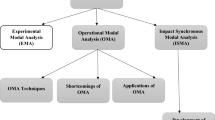Abstract
In this paper, an algorithm to assess the de-tuning of tuned mass dampers (TMD) while in operation is proposed. De-tuning of such smart structures occurs due to several reasons such as accidental changes in operating conditions or deterioration of the current modal properties which leads to significant loss of its performances. An accurate assessment of its de-tuning is needed to replace or re-tune TMDs. In the present work, a class of performance measures (PM) that are primary indicators of detuning is identified through an extensive parametric study followed by a regression model in which the PMs are regressed with the level of de-tuning. Principal component regression analysis is employed to eliminate co-linearity of the PM’s, in which the PMs are de-correlated through rotational transformation and a probabilistic de-tuning model is developed. Such regression model is extremely useful in detecting the detuning using the selected PMs based on the measurement alone. Experimental studies with the proposed algorithm on a laboratory set-up show promising results which makes it a potential candidate in structural health monitoring applications.

















Similar content being viewed by others
References
Abe M, Fujino Y (1994) Dynamic characterization of multiple tuned mass dampers and some design formulas. Earthq Eng Struct Dyn 23:813–835
Belouchrani A, Abed-Meraim K, Cardoso J, Moulines E (1997) A blind source separation technique using second-order statistics. IEEE Trans Signal Process 45(2):434–444
Chen G, Wu J (2003) Experimental study on multiple tuned mass dampers to reduce seismic responses of a three-storey building structure. Earthq Eng Struct Dyn 32(5):793–810
DenHartog J (1956) Mechanical vibration. McGraw-Hill, New York
Gamble S (2009) RWDI. private communication. RWDI
Gerges R, Vickery B (2005) Optimum design of pendulum-type tuned mass dampers. Struct Des Tall Special Build 14(4):353–368
Hazra B, Narasimhan S (2010) Wavelet-based blind identification of the UCLA factor building using ambient and earthquake responses. Smart Mater Struct 19(2). doi:10.1088/09641726/19/2/025005
Hazra B, Sadhu A, Roffel AJ, Paquet PE, Narasimhan S (2011) Under-determined blind identification of structure using the modified cross-correlation method. J Eng Mech ASCE. doi:10.1061/(ASCE)EM.1943-7889.0000328
Hazra B, Roffel AJ, Narasimhan S, Pandey MD (2010) Modified cross-correlation method for the blind identification of structures. J Eng Mech ASCE 136(7):889–897
Hazra B, Sadhu A, Lourenco R, Narasimhan S (2010) Retuning tuned mass dampers using ambient vibration response. Smart Mater Struct 19(11):13
Hazra B, Sadhu A, Roffel AJ, Narasimhan S (2011) Hybrid time-frequency blind source separation towards ambient system identification of structures. Comput Aided Civil Infrastruct Eng. doi:10.1111/j.1467-8667.2011.00732.x
Hoang N, Warnitchai P (2004) Design of multiple tuned mass dampers by using a numerical optimizer. Earthq Eng Struct Dyn 34(2):125–144
Huang N et al (1998) The empirical mode decomposition for the hilbert spectrum for nonlinear and non-stationary time series analysis. Proc R Soc Lond Ser 454:903–995
James G, Carne T, Lauffer J (1995) The natural excitation technique (net) for modal parameter extraction from operating structures. Modal Anal 10:260–277
Kareem A, Kijewski T (1999) Mitigation of motions of tall buildings with specific examples of recent applications. Wind Struct 2(3):201–251
Kareem A, Kline S (1995) Performance of multiple mass dampers under random loading. J Struct Eng 121(2):348–361
Kela L, Vahaoja P (2009) Recent studies of adaptive tuned vibration absorbers/neutralizers. Appl Mech Rev 62(6):060801
Kerschen G, Poncelet F, Golinval J (2007) Physical interpretation of independent component analysis in structural dynamics. Mech Syst Signal Process 21:1561–1575
Kwok KCS, Samali B (1995) Performance of tuned mass dampers under wind loads. Eng Struct 17(9):655–667
Lin CC, Hu CM, Wang JF, Hu RY (1994) Vibration control effectiveness of passive tuned mass dampers. J Chin Inst Eng 17:367–376
Lin CC, Wang JF, Ueng J (2001) Vibration control identification of seismically excited m.d.o.f. structure-ptmd systems. J Sound Vib 240(1):87–115
Lott WF (1973) The optimal set of principal component restrictions on a least squares regression. Commun Stat Theory Method 2:449–464
Nagarajaiah S, Varadarajan N (2005) Semi-active control of wind excited building with variable stiffness tmd using short-time Fourier transform. J Eng Struct 27:431–441
Rana R, Soong T (1998) Parametric study and simplified design of tuned mass dampers. Eng Struct 20(3):193–204
Ricciardelli F, Occhiuzz A, Clemente P (2000) Semi-active tuned mass damper control strategy for wind-excited structures. J Wind Eng Ind Aerodyn 88:57–74
Rowlings JO, Pantula SG, Dickey DA (1998) Applied regression analysis: a research tool, 2nd edn. Springer, New York
Setareh M, Ritchey JK, Murray TM, Koo J-H, Ahmadian M (2007) Semiactive tuned mass damper for floor vibration control. J Struct Eng 133(2):242–250
Spencer BF, Nagarajaiah S (2003) State of the art of structural control. J Struct Eng ASCE 129(7):845–856
Warburton GW (1982) Optimum absorber parameters for various combinations of response and excitation parameters. Earthq Eng Struct Dyn 10(3):381–401
Yang JN, Lei Y, Pan S, Huang N (2003) System identification of linear structures based on Hilbert Huang spectral analysis. Part Charact 1: normal modes. Earthq Eng Struct Dyn 32(9):1443–1467
Author information
Authors and Affiliations
Corresponding author
Rights and permissions
About this article
Cite this article
Hazra, B., Sadhu, A. Output-only de-tuning assessment of tuned mass dampers. J Civil Struct Health Monit 3, 33–48 (2013). https://doi.org/10.1007/s13349-012-0031-2
Received:
Revised:
Accepted:
Published:
Issue Date:
DOI: https://doi.org/10.1007/s13349-012-0031-2




